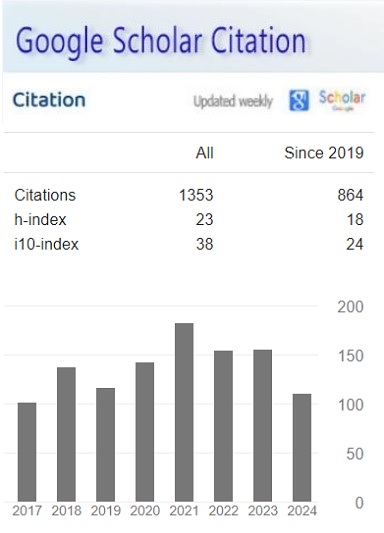Influence of Host plants on longevity, fecundity and Y-tube olfactometer response of Bemisia tabaci B (Hemiptera: Aleyrodidae)
Keywords:
Abstract
The whitefly, Bemisia tabaci B (Hemiptera: Aleyrodidae) is one of the serious sucking pest insects throughout the world on vegetables, fruits, ornamentals, and broad leaf agronomic crops. In this experiment, we observed fecundity and adult longevity of B. tabaci on four different host plants and compare its host plant attraction through a Y-tube olfactometer. Results showed that daily fecundity was different in the entire period of B. tabaci life and more number of total eggs laid on eggplant and medium on tomato and cucumber and lower on pepper. Female life longevity was higher than male life where both of them survive longer on eggplant, medium on tomato and cucumber, and lower on pepper. The Y-tube olfactometer results showed that comparison preferences between cucumber vs. eggplant and tomato vs. eggplant did not differ significantly. Host plant attraction between tomato vs. cucumber, eggplant vs. pepper, cucumber vs. pepper, and tomato vs. pepper differed significantly. The olfactometer results confirmed that eggplant, cucumber, and tomato are preferred hosts where pepper is the non-preferred host for B. tabaci B. These basic results will provide important information for a better understanding of B. tabaci biology as well as dispersal subject to the development of management strategies to successfully combat infestations of the whitefly in a cropping system with different crops.
References
Ahmed, M.Z., De Barrow, P.J., Ren, S.X., Greeff, J.M., Qiu, B.L., 2013. Evidence for horizontal transmission of secondary endosymbionts in the Bemisia tabaci cryptic species complex. PLoS ONE 8, e53084. DOI: https://doi.org/10.1371/journal.pone.0053084
Al-Zyoud, F., Sengonca, C., 2004. Development, longevity and fecundity of Bemisia tabaci (Genn.) (Hom., Aleyrodidae) on different host plants at two temperatures. Mitt. Dtsch. Ges. allg. angew. Ent. 14. 375-378.
Berdegué, M., Reitz, S.R., Trumble, J.T., 1998. Host plant selection and development in Spodoptera exigua: Do mother and offspring know best? Entomol. Exp. Appl. 89: 57-64. doi:10.1046/j.1570-7458.1998.00381.x. DOI: https://doi.org/10.1046/j.1570-7458.1998.00381.x
Bernays, E.A., Chapman, R.F., 1994. Host-Plant Selection by Phytophagous Insects. New York, NY: Chapman and Hall. doi: 10.1007/b102508 DOI: https://doi.org/10.1007/b102508
Bing, X.L., Yang, J., Zchori-Fein, E., Wang, X.W., Liu, S.S., 2013. Hemipteriphilus asiaticus, a newly-described whitefly symbiont, In: First International Whitefly Symposium, Kolymbari, Crete, Greece. p. 83.
De Barro, P.J., Bourne, A., 2010. Ovipositional host choice by an invader accelerates displacement of its indigenous competitor. Biol. Invasions 12:3013-3023 doi: 10.1007/s10530-010-9691-1 DOI: https://doi.org/10.1007/s10530-010-9691-1
De Barro, P.J., Bourne, A., Khan, S.A., Brancatini, V.A.L., 2006. Host plant and biotype density interactions - their role in the establishment of the invasive B biotype of Bemisia tabaci Biological Invasions 8: 287-294. doi: 10.1007/s10530-005-1261-6 DOI: https://doi.org/10.1007/s10530-005-1261-6
De Barro, P.J., Liu, S.S., Boykin, L.M., Dinsdale, A.B., 2011. Bemisia tabaci: A statement of species status. Annu. Rev. Entomol. 56: 1-19. DOI: https://doi.org/10.1146/annurev-ento-112408-085504
De Barro, P.J., Trueman, W.H., Frohlich, D.R., 2005. Bemisia argentifolii is a race of B. tabaci (Hemiptera: Aleyrodidae): the molecular genetic differentiation of B. tabaci populations around the world. Bull. Entomol. Res. 95: 193-203.
De Barro, P.J., Trueman, W.H., Frohlich, D.R., 2005. Bemisia argentifolii is a race of B. tabaci (Hemiptera: Aleyrodidae): the molecular genetic differentiation of B. tabaci populations around the world. Bull. Entomol. Res. 95: 193-203. DOI: https://doi.org/10.1079/BER2004351
Dicke, M., Baldwin, I.T., 2010. The evolutionary context for herbivore induced plant volatiles: beyond the ‘cry for help’. Trends Plant Sci. 15, 167-175. doi: 10.1016/j.tplants.2009.12.002 DOI: https://doi.org/10.1016/j.tplants.2009.12.002
Dinsdale, A., Cook, L., Riginos, C., Buckley, Y.M., De Barro, P.J., 2010. Refined global analysis of Bemisia tabaci (Hemiptera: Sternorrhyncha: Aleyrodoidea: Aleyrodidae) mitochondrial cytochrome oxidase I to identify species level genetic boundaries. Ann. Entomol. Soc. Am. 103: 196-208. DOI: https://doi.org/10.1603/AN09061
Finch, S., 1980. “Chemical attraction of plant-feeding insects to plants,” in Applied Biology, ed. T. H. Coaker (New York, NY: Academic Press), 67-143.
Frohlich, D.R., Torres-Jerez, I., Bedford, I.D., Markham, P.G., Brown, J.K., 1999. A phylogeographical analysis of Bemisia tabaci species complex based on mitochondrial DNA markers. Mol. Ecol. 8: 1683-1691. doi: 10.1046/j.1365-294x.1999.00754.x. PubMed: 10583831 DOI: https://doi.org/10.1046/j.1365-294x.1999.00754.x
Gonzalez-Zamora, J.E., Gallardo, J.M., 1999. Development and reproduction of Bemisia tabaci (GENN.) (Hom., Aleyrodidae) on sweet pepper at three temperatures. Boletin-de-Sanidad-Vegetal 25: 3-11.
Gripenberg, S., Mayhew, P.J., Parnell, M., Roslin, T., 2010. A meta-analysis of preference-performance relationship in phytophagous insects. Ecol. Lett. 13: 383-393. doi:10.1111/j.1461-0248.2009.01433.x. PubMed: 20100245. DOI: https://doi.org/10.1111/j.1461-0248.2009.01433.x
Gruenhagen, N.M., Perring, T.M., 2001. Plant influences on silverleaf whitefly oviposition and development and the potential for enemy-free space. Entomol. Exp. Appl. 99: 387-391. doi:10.1046/j.1570-7458.2001.00839.x. DOI: https://doi.org/10.1046/j.1570-7458.2001.00839.x
Hu, X.S., Dennehy, T.J., Ni, X.Z., Zhao, H.Y., Nichols, R.L., Li, X.C., 2011. Potential adaptation of a Q biotype whitefly population from poinsettia to field crops. Insect Sci. 18: 719-728. DOI: https://doi.org/10.1111/j.1744-7917.2011.01405.x
Islam MN, Hasanuzzaman ATM, Zhang Z-F, Zhang Y and Liu T-X (2017) High Level of Nitrogen Makes Tomato Plants Releasing Less Volatiles and Attracting More Bemisia tabaci (Hemiptera: Aleyrodidae). Front. Plant Sci. 8:466. doi: 10.3389/fpls.2017.00466 DOI: https://doi.org/10.3389/fpls.2017.00466
Li, T.Y., Maschwitz, U., 1985. The sexual behavior of whitefly Trialeurodes vaporariorum. Acta Entomol. Sin. 28, 233-235.
Liu, S.S., Colvin, J., De Barro, P.J., 2012. Species concepts as applied to the whitefly Bemisia tabaci systematic: how many species are there? J. Integr. Agric. 11: 176-186. DOI: https://doi.org/10.1016/S2095-3119(12)60002-1
Liu, T.X., 2007. Life history of Eretmocerus melanoscutus (Hymenoptera: Aphelinidae) parasitizing nymphs of Bemisia tabaci biotype B (Homoptera: Aleyrodidae). Biol. Control 42: 77-85. DOI: https://doi.org/10.1016/j.biocontrol.2007.03.008
Liu, T.X., Stansly, P.A., 1995. Oviposition by Bemisia argentifolii (Homoptera: Aleyrodidae): Effects of tomato leaf factors and insecticidal residues. J. Econ. Entomol. 88: 992-997. DOI: https://doi.org/10.1093/jee/88.4.992
Luis, L.M., Alex, I.C., Esaú, R.S., H, B.G., Ignacio, I.F., Wilberth, C.C., Daniel, G.M., 2015. Survival of Bemisia tabaci and activity of plant defense-related enzymes in genotypes of Capsicum annuum L. Chilean J. Agril. Res. 75: 71-77 doi:10.4067/S0718-58392015000100010 DOI: https://doi.org/10.4067/S0718-58392015000100010
Mansaray. A., Sundufu, A.J., 2009. Oviposition, development and survivorship of the sweetpotato whitefly Bemisia tabaci on soybean, glycine max, and the garden bean, Phaseolus vulgaris. J. Insect Sci. 9:1. doi: 10.1673/031.009.0101. PMID: 19611218; PMCID: PMC3011826. DOI: https://doi.org/10.1673/031.009.0101
Martin, J.H., Mifsud, D., Rapisarda, C., 2000. The whiteflies (Hemiptera: Aleyrodidae) of Europe and Mediterranean Basin. Bull. Entomol. Res. 90: 407-448. DOI: https://doi.org/10.1017/S0007485300000547
Mayer, R.T., Inbar, M., McKenzie, C.L., Shatters, R., Borowicz, V. et al., 2002. Multitrophic interactions of the silverleaf whitefly, host plants, competing herbivores, and phytopathogens. Arch. Insect Biochem. Physiol. 51: 151-169. DOI: https://doi.org/10.1002/arch.10065
Mayhew, P.J., 1997. Adaptive patterns of host-plant selection by phytophagous insects. Oikos 79: 417-428. doi:10.2307/3546884. DOI: https://doi.org/10.2307/3546884
Mumm, R., Dicke, M., 2010. Variation in natural plant products and the attraction of body guards for indirect plant defense. Can. J. Zool. 88, 628-667. doi: 10.1139/Z10-032 DOI: https://doi.org/10.1139/Z10-032
Naranjo, S.E., Ellsworth, P.C., 2009. The contribution of conservation biological control to integrated pest control of Bemisia tabaci in cotton. Biol. Control 51: 458-470. DOI: https://doi.org/10.1016/j.biocontrol.2009.08.006
Nava-Camberos U, David, G.R., Marvin, K.H., 2001. Temperature and Host Plant Effects on Development, Survival, and Fecundity of Bemisia argentifolii (Homoptera: Aleyrodidae), Environ. Entom. 30: 55-63. DOI: https://doi.org/10.1603/0046-225X-30.1.55
Oliveira, M.R.V., Henneberry, T.J., Anderson, P., 2001. History, current status, and collaborative research projects for Bemisia tabaci. Crop Protect. 20: 709-723. doi:10.1016/S0261-2194(01)00108-9. DOI: https://doi.org/10.1016/S0261-2194(01)00108-9
Omondi, A.B., Obeng-Ofori, D., Kyerematen, R.A., Danquah, E.Y., 2005. Host preference and suitability of some selected crops for two biotypes of Bemisia tabaci in Ghana. Entomol. Exp. Appl. 115: 393-400. doi: 10.1111/j.1570-7458.2005.00296.x. DOI: https://doi.org/10.1111/j.1570-7458.2005.00296.x
Perring, T.M., 2001. The Bemisia tabaci species complex. Crop Prot. 20: 725-737. DOI: https://doi.org/10.1016/S0261-2194(01)00109-0
Powell, D.A., Bellows Jr, T.S., 1992. Adult longevity, fertility and population growth rates for Bemisia tabaci (Genn.) (Homoptera: Aleyrodidae) on two host plant species. J. Appl. Ent. 113: 68-78 doi:10.1111/j.1439-0418.1992.tb00637.x DOI: https://doi.org/10.1111/j.1439-0418.1992.tb00637.x
Saad, K.A., Roff, M.N.M., Hallett, R.H., Idris, A.B., 2015. Aphid-induced defenses in chilli affect preferences of the whitefly, Bemisia tabaci (Hemiptera: Aleyrodidae). Sci. Rep. 5:13697.doi:10.1038/srep13697 DOI: https://doi.org/10.1038/srep13697
Shah, M.M.R., Liu, T.X., 2013. Feeding experience of Bemisia tabaci (Hemiptera: Aleyrodidae) affects their performance on different host plants. PLoS ONE 8, e77368. DOI: https://doi.org/10.1371/journal.pone.0077368
Shah, M.M.R., Zhang, S., Liu, T., 2015. Whitefly, Host Plant and Parasitoid: A Review on Their Interactions. Asian J. Appl. Sci. Eng. 4: 48-61.
Unsicker, S.B., Kunert, G., Gershenzon, J., 2009. Protective perfumes: the role of vegetative volatiles in plant defense against herbivores. Curr. Opin. Plant Biol. 12, 479-485. doi: 10.1016/j.pbi.2009.04.001 DOI: https://doi.org/10.1016/j.pbi.2009.04.001
Wang, P., Sun, D.B., Qiu, B.L., Liu, S.S., 2011. The presence of six cryptic species of the whitefly Bemisia tabaci complex in China as revealed by crossing experiments. Insect Sci. 18: 67-77. DOI: https://doi.org/10.1111/j.1744-7917.2010.01381.x
Xu, J., Lin, K.K., Liu, S.S., 2011. Performance on different host plants of an alien and an indigenous Bemisia tabaci from China. J. Appl. Entomol. 135: 771-779. DOI: https://doi.org/10.1111/j.1439-0418.2010.01581.x
Downloads
Published
How to Cite
Issue
Section
License
Copyright (c) 2021 Asian Journal of Applied Science and Engineering

This work is licensed under a Creative Commons Attribution-NonCommercial 4.0 International License.








